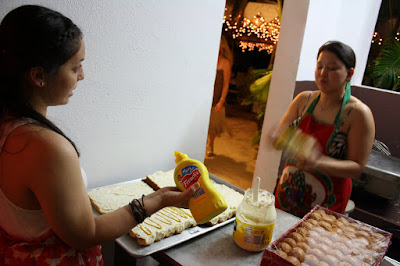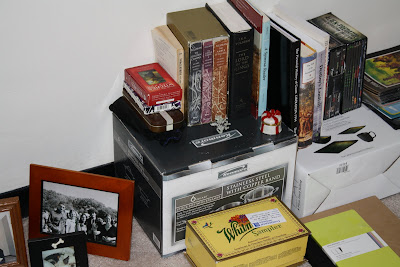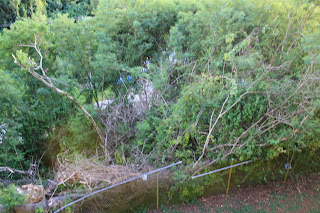
It may be the wall-to-wall commercial radio that plays an endless rotation of songs about
drunken girl brawling,
suicide games and
cartoonish sexual longing, but I think I might be getting into Bob Dylan.
Having previously scorned all Bob Dylan songs because the sale his album of contemporary hits at Starbucks deeply offended my post-college ideologically purist impulses as a member of the proletarian barista class, my change of heart stems mainly (entirely) from
the one song I heard this weekend about tarot.
The song was introduced to me not accidentally, as it features lyrics about the moon, and swords and Kings and Queens, the burning of Eden and the Tower, evoking obvious tarot interpretations, that or
Christian religious revelation, whichever.
I started reading tarot cards after I graduated college, having ganked a deck of Victorian-themed cards I had bought for a former friend with whom things were not working out.
At first I read for myself -- timidly laying out the cards in repetition while trying to read into them the things I wanted, only to find out that no, actually, tarot does not just tell you the things you want to hear. It then turned into sort of a party trick; it allowed me to both avoid social interaction, and gain access to the intimate details of the lives of people I was otherwise too awkward to make conversation with.
And then, I don't know, it became a habit, a frame of reference, and later a kind of shorthand for the things in my life I couldn't quite express or explain any other way.
Certain cards became stand-ins for people -- the Sun, the King of Wands, the Emperor, the Dilettante.
I could quickly sum up other people's convoluted emotional dramas with pat phrases: the "slutty girl" card, the "first date" card, the "boon" card, the "wandering up the hillside by yourself" card, the "doing stuff you're not supposed to be doing" card, the “orgy” card.
Cards whose more esoteric meanings had been lost on me at 22, suddenly became clear as I walked my way through those experiences you think you understand until you actually have them, and realize, that yes, it's just like everyone said it would be when you rolled your eyes at 15.
I got lost in the rituals of labyrinthine institutions (the Hierophant), tried to be the change I wanted to see through sheer force of will (Temperance), and when that failed, I tried more rigorous methods (Justice), and repeatedly had to move myself instead of the mountain (Death).
The Tower, however, is a card that I always understood, even in the first days of experimenting, probably due to my proclivity for burning down my life every three to four years.
For those of you unfamiliar with the Tower, it is best explained as being less like death and more like an earthquake -- a shattering force that cannot be reasoned with or controlled and must be ridden, down to the bottom of the burning rubble pile, to see what is left.
Its emergence in one’s life usually has to do with the destruction of things we cannot maintain, whose collapse is inevitable.
Like a forest fire that, you know, renews the soil or something, I've always told myself this was a healthy and natural process. And like
that other song that appeals to adolescent girls everywhere, I have always found the jumping to be easy, and falling fairly fun.
This has never sat well with my boyfriend, who has always had a less cavalier attitude toward change, especially the painful and destruction kind (go figure), than me.
I met him when I was 22, as I was assessing the Rest of My Life working amongst the dusty tottering bookshelves and the rotating cast of grungy post-college wanna-be hipsters, whose ranks I had just joined at the Strand bookstore.
He was 23-year-old slouching former film student, still recovering from dashed college aspirations and coasting into the surreal world of adult disappointment, unable to grasp the grinding day-to-day reality of being untethered from the hopes of what would be, for more concrete tasks, like reorganizing window displays.
He was the first person I recognized as a person, someone who was not just an object to be scrutinized, but with whom I would actually have a human relationship. And, as I told myself when we briefly passed each other pushing Strand carts down the crowded aisles, I would have an affair with him.
I remember that I used that phrase exactly, in my mind. I still wonder why, because I didn’t have affairs at the time, let alone with boys. Maybe a day later, when I learned his full name, an honest, no frills Anglo-Saxon name, I thought to myself, "I'm going to marry someone like this."
I have told this story many times, somewhat apocryphally, with a twinge of irony and a sly smile, but I still believe it, I think.
Because from then on I chased him, and he dodged and occasionally came my way, and then changed his mind often enough to keep me interested. And I kissed him often, in parks and on corners, and in the rain and the back of the Strand.
And the first Towers I received in readings from circa 2004 had to do with him. But even as far back as those days, he was part of my Plan. He was my only plan.
I moved away; I came back. We moved in together, and survived New York apartments, unemployment and crazy retail bosses and temp jobs, bed bugs, cockroaches, film school roommates, anarchists and academics, each other, and, until now, my propensity for jumping off things.
I've burned down things before -- things I knew I was too young for, things I realized I never wanted, things I knew would never be mine -- but it has never occurred to me, until now, I think, that there could be important things, things that we are meant to do, that might not survive the ashes.
I still don't wholly believe it.
Last year, he and I ran into a gypsy on a subway car. We assume she was a gypsy because she looked vaguely Eastern European, and also spoke a language I didn’t recognize to what we presumed to be her daughter and grandson. Plus, we had just seen that Sam Raimi movie about gypsy curses, so, it seemed likely.
At any rate, she offered us palm readings, after Keith volunteered to help her redesign her home-computer-made psychic reading flyer, advertising “tarrot” readings and other illuminating psychic services.
For some reason we acquiesced, and there on the subway car she told him things he had heard before, about difficulties and strife, and overcoming challenges, after which there would be celebrations and parties. And she told me things I assumed she thought I wanted to hear: that I was still learning, was particularly sensitive to the need for the sun, and that I was going to move someplace tropical.
He last prediction, which I dismissed out of hand, and to which Keith scoffed disdainfully, "she can say whatever she wants..." was that I would be married in a year.
Things in my life have worked out differently than I have expected in almost every way possible, and none of my Plans have really ever worked out the way I wanted them to.
But, now I am living on a tropical island, and learning new things, and actually enjoying the sun.
So, at least for now, I am going to believe that there must be some truth in gypsy palm readings, and in those flashes of insight we have, even when we’re too young to know what they really mean.
 To save me from the fate of spending my first Christmas on Guam eating hard-boiled eggs alone in my apartment, a colleague of mine invited me to his annual Christmas gathering.
To save me from the fate of spending my first Christmas on Guam eating hard-boiled eggs alone in my apartment, a colleague of mine invited me to his annual Christmas gathering. That being said, I was still surprised to arrive at a family gathering to find out that I was attending was actually a very large, seemingly public party, held at the regal, cliff-side estate (above) of one of the better known local patriarchs, who owns a beer distributing company on the island.
That being said, I was still surprised to arrive at a family gathering to find out that I was attending was actually a very large, seemingly public party, held at the regal, cliff-side estate (above) of one of the better known local patriarchs, who owns a beer distributing company on the island. There was a roasted pig (left) and the governor (apparently), a mixture of people who looked like family and people who were clearly not, like myself, and the young white guy from D.C. who is heading up the 2010 census on the island.
There was a roasted pig (left) and the governor (apparently), a mixture of people who looked like family and people who were clearly not, like myself, and the young white guy from D.C. who is heading up the 2010 census on the island. Toward 10pm, I found Jojo, who was busy in an large, open-air kitchen. There were still trays of unfinished desserts, main courses, a half-eaten pig and appetizers lying about, but he showed me a fully baked, brand new ham in a roast pan. Apparently they used to make sandwiches with leftovers for the second-wave of gorging, only for it to become a tradition on its own, thus requiring a ham.
Toward 10pm, I found Jojo, who was busy in an large, open-air kitchen. There were still trays of unfinished desserts, main courses, a half-eaten pig and appetizers lying about, but he showed me a fully baked, brand new ham in a roast pan. Apparently they used to make sandwiches with leftovers for the second-wave of gorging, only for it to become a tradition on its own, thus requiring a ham.
















































